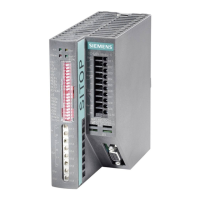© Siemens AG, 2009 8/18
3.4 Alarm Messages
3.4.1 Lack of Buffer Readiness
If the "Lack of Buffer Readiness" signal appears, the red LED (Alarm) lights up and the X2.4 – X2.5 relay
contact (Alarm) is made (idle position in case of deactivated device). Causes for a lack of buffer readiness in
normal mode could include the following:
Operating state OFF, no battery module connected, reversed or defective battery (battery voltage < 18.5V), or
wire breakage between the battery and the UPS module.
The ON/OFF operating state, the battery status (reversed, defective, or non-existent), wire breakage, and the
output of the signal are polled in normal mode every 20s. At the end of a malfunction, a reset takes place after
the next poll.
In buffer mode, the "Alarm" signal means that the battery voltage has sunk to <20.4V and an automatic
deactivation to protect the battery is pending. After the battery is shut down due to overload, short circuit,
exhaustive discharge protection, or an expired buffering time, the red LED (Alarm) extinguishes, but the X2.4 –
X2.5 relay contact remains made.
3.4.2 Battery Change Required
If the "Alarm" signal and the X2.4 – X2.5 relay contact (Alarm) are blinking in a 2s cycle, the battery is defective,
but buffer mode can still take place. The set buffering times, however, can no longer be observed. An exchange
of the battery module is required.
4. Communication with the PC (Only Devices with Serial or USB Interface)
SITOP DC UPS modules with serial or USB interfaces can also send operating state data to a connected PC or
also receive remote signals. The signals (Table 10 and Diagram 1) can be integrated into their own applications
according to their content or further processed on the PC using the "SITOP DC UPS Software" freeware tool.
This tool is available for download under http://www.siemens.com/sitop
.
4.1 Design of Interface
4.1.1 Serial Connection
(6EP1931-2DC31 and 6EP1931-2EC31)
- Output of the signal states every 84ms 20%, 29ms 20% data output, 55ms 20% break
- Setting the interface: 9600 baud, 8 data bits; 1 stop bit, no parity bit
- Safe, electrical disconnection according to EN 60950
The connection to the PC takes place using a 1:1 connected 9-pole SUB-D extension cable (plug/socket),
whereby only three poles are required:
Pin 2 (Pin 3 in case of 25-pole plug/socket): RxD (data line)
Pin 3 (Pin 2 in case of 25-pole plug/socket): TxD (negative supply for interface)
Pin 7 (Pin 4 in case of 25-pole plug/socket): RTS (positive supply for interface)

